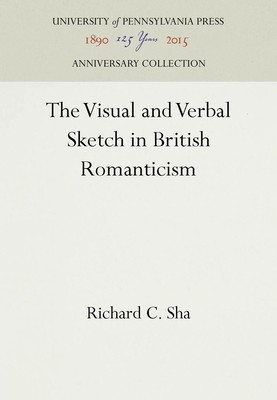
- We will send in 10–14 business days.
- Author: Richard C Sha
- Publisher: University of Pennsylvania Press Anniversary Collection
- ISBN-10: 0812234200
- ISBN-13: 9780812234206
- Format: 15.8 x 23.4 x 2.5 cm, hardcover
- Language: English
- SAVE -10% with code: EXTRA
The Visual and Verbal Sketch in British Romanticism (e-book) (used book) | bookbook.eu
Reviews
Description
With their broken lines and hasty brushwork, sketches acquired enormous ideological and aesthetic power during the Romantic period in England. Whether publicly displayed or serving as the basis of a written genre, these rough drawings played a central role in the cultural ferment of the age by persuading audiences that less is more.
The Visual and Verbal Sketch in British Romanticism investigates the varied implications of sketching in late-eighteenth- and early-nineteenth-century culture. Calling on a wide range of literary and visual genres, Richard C. Sha examines the shifting economic and aesthetic value of the sketch in sources ranging from auction catalogs and sketching manuals to novels that employed scenes of sketching and courtship. He especially shows how sketching became a double-edged accomplishment for women when used to define proper femininity. Sha's work offers fresh readings of Austen, Gilpin, Wordsworth, and Byron, as well as less familiar writers, and provides sophisticated interpretations of visual sketches. As the first full-length work about sketching during the Romantic era, this volume is a rich interdisciplinary study of both representation and gender.EXTRA 10 % discount with code: EXTRA
The promotion ends in 15d.01:21:36
The discount code is valid when purchasing from 10 €. Discounts do not stack.
- Author: Richard C Sha
- Publisher: University of Pennsylvania Press Anniversary Collection
- ISBN-10: 0812234200
- ISBN-13: 9780812234206
- Format: 15.8 x 23.4 x 2.5 cm, hardcover
- Language: English English
With their broken lines and hasty brushwork, sketches acquired enormous ideological and aesthetic power during the Romantic period in England. Whether publicly displayed or serving as the basis of a written genre, these rough drawings played a central role in the cultural ferment of the age by persuading audiences that less is more.
The Visual and Verbal Sketch in British Romanticism investigates the varied implications of sketching in late-eighteenth- and early-nineteenth-century culture. Calling on a wide range of literary and visual genres, Richard C. Sha examines the shifting economic and aesthetic value of the sketch in sources ranging from auction catalogs and sketching manuals to novels that employed scenes of sketching and courtship. He especially shows how sketching became a double-edged accomplishment for women when used to define proper femininity. Sha's work offers fresh readings of Austen, Gilpin, Wordsworth, and Byron, as well as less familiar writers, and provides sophisticated interpretations of visual sketches. As the first full-length work about sketching during the Romantic era, this volume is a rich interdisciplinary study of both representation and gender.

Reviews